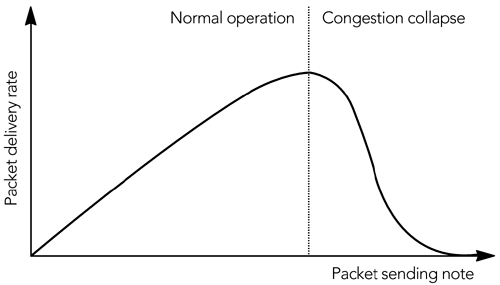The Need for Congestion Control
| Before we discuss the congestion control mechanisms employed on the Internet, and the implications they have for multimedia traffic, it is important to understand what congestion control is, why it is needed, and what happens if applications are not congestion-controlled. As we discussed in Chapter 2, Voice and Video Communication over Packet Networks, an IP network provides a best-effort packet-switched service. One of the defining characteristics of such a network is that there is no admission control. The network layer accepts all packets and makes its best effort to deliver them. However, it makes no guarantees of delivery, and it will discard excess packets if links become congested . This works well, provided that the higher-layer protocols note packet drops and reduce their sending rate when congestion occurs. If they do not, there is a potential for congestion collapse of the network. Congestion collapse is defined as the situation in which an increase in the network load results in a decrease in the number of packets delivered usefully by the network. Figure 10.1 shows the effect, with a sudden drop in delivery rate occurring when the congestion collapse threshold is exceeded. Congestion collapse arises when capacity is wasted sending packets through the network that are dropped before they reach their destination ”for example, because of congestion at intermediate nodes. Figure 10.1. Congestion Collapse Consider a source sending a packet that is dropped because of congestion. That source then retransmits the packet, which again is dropped. If the source continues to resend the packet, and the other network flows remain stable, the process can continue with the network being fully loaded yet no useful data being delivered. This is congestion collapse. It can be avoided if sources detect the onset of congestion and use it as a signal to reduce their sending rate, allowing the congestion to ease. Congestion collapse is not only a theoretical problem. In the early days of the Internet, TCP did not have an effective congestion control algorithm, and the result was networkwide congestion collapse on several occasions in the mid-1980s. 3 To prevent such collapse, the TCP protocol was augmented with the mechanisms developed by Van Jacobson, 81 which are described in the next section, Congestion Control on the Internet. With the increase in non-congestion-controlled multimedia traffic, the potential for congestion collapse is again becoming a concern. Various mechanisms have been proposed by which routers can detect flows that do not respond to congestion 73 and penalize those flows with higher loss rates than those that are responsive . Although these mechanisms are not widely deployed at present, it is likely that in the future the network will be more actively policed for compliance with the principles of congestion control. In addition to congestion collapse, there is another reason for employing congestion control: fairness. The policy for sharing network capacity among flows is not defined by IP, but by the congestion control algorithms of the transport protocols that run above it. The model adopted by TCP is to share the available capacity approximately evenly among all flows. Multimedia flows that use different congestion control algorithms upset this fair sharing of resources, usually to the detriment of TCP (which is squeezed out by the more aggressive multimedia traffic). Although it may be desirable to give multimedia traffic priority in some cases, it is not clear that multimedia traffic is always more important than TCP traffic, and that it should always get a larger share of the network capacity. Mechanisms such as Differentiated Services 23 , 24 and Integrated Services/RSVP 11 allow for some flows to be given priority in a controlled way, based on application needs, rather than in an undifferentiated manner based on the transport protocol they employ . However, these service prioritization mechanisms are not widely deployed on the public Internet. |
EAN: 2147483647
Pages: 108
